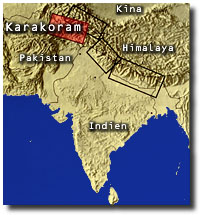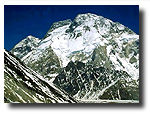Himalaya -
The worlds most immense mountain range
 Himalaya
is the worlds most highest mountain range. It
ranges apx. 2500 km long bow, where it's widets
point is in the west (apx. 200km) and highest in
the east (up to 8848m). The name means "the
snows housing". The mountain range stretches
from the Indus valley in the west to the
Brahmaputras valley in the east. The mountain
range makes up an unaccessible and mythlogical
barrier between the Indienflatlands and Central
Asias high plateau. Himalaya
is the worlds most highest mountain range. It
ranges apx. 2500 km long bow, where it's widets
point is in the west (apx. 200km) and highest in
the east (up to 8848m). The name means "the
snows housing". The mountain range stretches
from the Indus valley in the west to the
Brahmaputras valley in the east. The mountain
range makes up an unaccessible and mythlogical
barrier between the Indienflatlands and Central
Asias high plateau. |

|
 Himalaya has 14 peaks above 8000
meters. Several of the highest peaks -
Mt.Everest, Kanchenjunga, Makalu and Annapurna
are located in Nepal.Advanced alpinists consider
these peaks as the greatest challenges. Himalaya has 14 peaks above 8000
meters. Several of the highest peaks -
Mt.Everest, Kanchenjunga, Makalu and Annapurna
are located in Nepal.Advanced alpinists consider
these peaks as the greatest challenges.The difference in elevation
between the Indus valley and Nagna Parbat in the
northwest, which is only a few kilometers from
there, is 7000 meters, and further out east the
elevation difference is almost 8000 meters of a
stretch no more than 100 km.
|

Broad Peak |

The Baltoro glacier |
The
over hanging risk for avalanches, and suprise
snowstorms along with the extreme thin air all
attempts have a risk factor... Besides all of the
peaks there are about 300 glaciers in the area.
More about the glaciers... |

 Alpinists Alpinists
 The
Himalaya moutain ranges The
Himalaya moutain ranges
 Himalaya is part of a system of
parallell mountain ranges. This chain developed during
the kritera and tretiar era. Time has produced a mountain
range torn apart by deep and narrow valleys. From
Transhimalaya in Tibet, Himalaya is divided by the
elongated valleys where the rivers Indus and Brahmaputra
connect. Even the river Gagnes has its origins in the
Himalayas. Himalaya is part of a system of
parallell mountain ranges. This chain developed during
the kritera and tretiar era. Time has produced a mountain
range torn apart by deep and narrow valleys. From
Transhimalaya in Tibet, Himalaya is divided by the
elongated valleys where the rivers Indus and Brahmaputra
connect. Even the river Gagnes has its origins in the
Himalayas.
 The large mountain chain creates a
sharp border between climates, the tropical Indien, the
heavily percipitated monsun climate and the dry and
wintery Central Asian area. The snow level lies between
4500 and 6000m, forest area at apx. 1000m lower. Below
the main chain the mountains are covered by forest and
are made up of steep formations. On the percipitative
southside tropical plants grow along with sub-tropical
rain forests up to about 2500m height. Further up forests
with birch, oak and different pine-forest. In these areas
exist a rich wild life where such animals as leopards,
tigers and elephants can be found. The north-side which
gives very little percipitation exists mainly of desert
or steppe. The large mountain chain creates a
sharp border between climates, the tropical Indien, the
heavily percipitated monsun climate and the dry and
wintery Central Asian area. The snow level lies between
4500 and 6000m, forest area at apx. 1000m lower. Below
the main chain the mountains are covered by forest and
are made up of steep formations. On the percipitative
southside tropical plants grow along with sub-tropical
rain forests up to about 2500m height. Further up forests
with birch, oak and different pine-forest. In these areas
exist a rich wild life where such animals as leopards,
tigers and elephants can be found. The north-side which
gives very little percipitation exists mainly of desert
or steppe.
 It is only the higher portions of
Himalaya that have a genuine alpine character. This
distinct ice region rises 3000 - 4000m above the front
part of Himalaya. In this fantastic mountain range some
of the worlds highest mountains can be found, where no
less than 14 of them are 8000m or higher and apx. 30 of
them above 7600m. A common feature amoungst these
mountains are the 2000-3000m peaks, along with high ice
covered walls that are vertically shaped into the
valleys. A known example of one of the walls is the
Lhotse-Nuptse wall. It is only the higher portions of
Himalaya that have a genuine alpine character. This
distinct ice region rises 3000 - 4000m above the front
part of Himalaya. In this fantastic mountain range some
of the worlds highest mountains can be found, where no
less than 14 of them are 8000m or higher and apx. 30 of
them above 7600m. A common feature amoungst these
mountains are the 2000-3000m peaks, along with high ice
covered walls that are vertically shaped into the
valleys. A known example of one of the walls is the
Lhotse-Nuptse wall.
More
on the "14 giants"...

 Precipitation Precipitation
 The moisturous tropical air masses
from the Indien Ocean releases its precipitation on
Himalayas southern slopes. Even though the winter is a
very dry period, an average of 6000 mm rain is measured
per year. This causes the south side of Himalaya to be
one of the worlds rainiest and most populated areas in
the world. Intensive farming is the main occupation. The
northern slope in contrast to the southern slopes which
exists of rain forests one can find wintery dry steppe
which is not vey populated at all. The moisturous tropical air masses
from the Indien Ocean releases its precipitation on
Himalayas southern slopes. Even though the winter is a
very dry period, an average of 6000 mm rain is measured
per year. This causes the south side of Himalaya to be
one of the worlds rainiest and most populated areas in
the world. Intensive farming is the main occupation. The
northern slope in contrast to the southern slopes which
exists of rain forests one can find wintery dry steppe
which is not vey populated at all.

 The
People The
People
 Himalaya is not very populated. The
mountain people live on agriculture and stock-farming. In
the higher mountain ranges they regularly move the stock
between different pastures. I these isolated areas the
myth of the "snow man" still exists. On the
slopes of Himalaya towards India several well known
resorts such as Simla and Darjeeling exist, here one can
escape from the burning hot flatlands. Himalaya is not very populated. The
mountain people live on agriculture and stock-farming. In
the higher mountain ranges they regularly move the stock
between different pastures. I these isolated areas the
myth of the "snow man" still exists. On the
slopes of Himalaya towards India several well known
resorts such as Simla and Darjeeling exist, here one can
escape from the burning hot flatlands.

Latest News  Log-book Log-book  Weather Weather  Maps Maps  Description Description  Procedure Procedure
Participants  Trekking Gruope Trekking Gruope  Himalaya Himalaya  Pakistan Pakistan  Hidden Peak Hidden Peak  Gallery Gallery
Equipement  Sponsors Sponsors  Links Links  Press Clippings Press Clippings  Other Other
 Contact Us Contact Us  Back home... Back home...

Web Design and
internet provider - Teknikhuset i Umeć, Sweden
© Copyright 1997 Svenska Hidden Peak Expeditionen 1997
All rights reserved
|